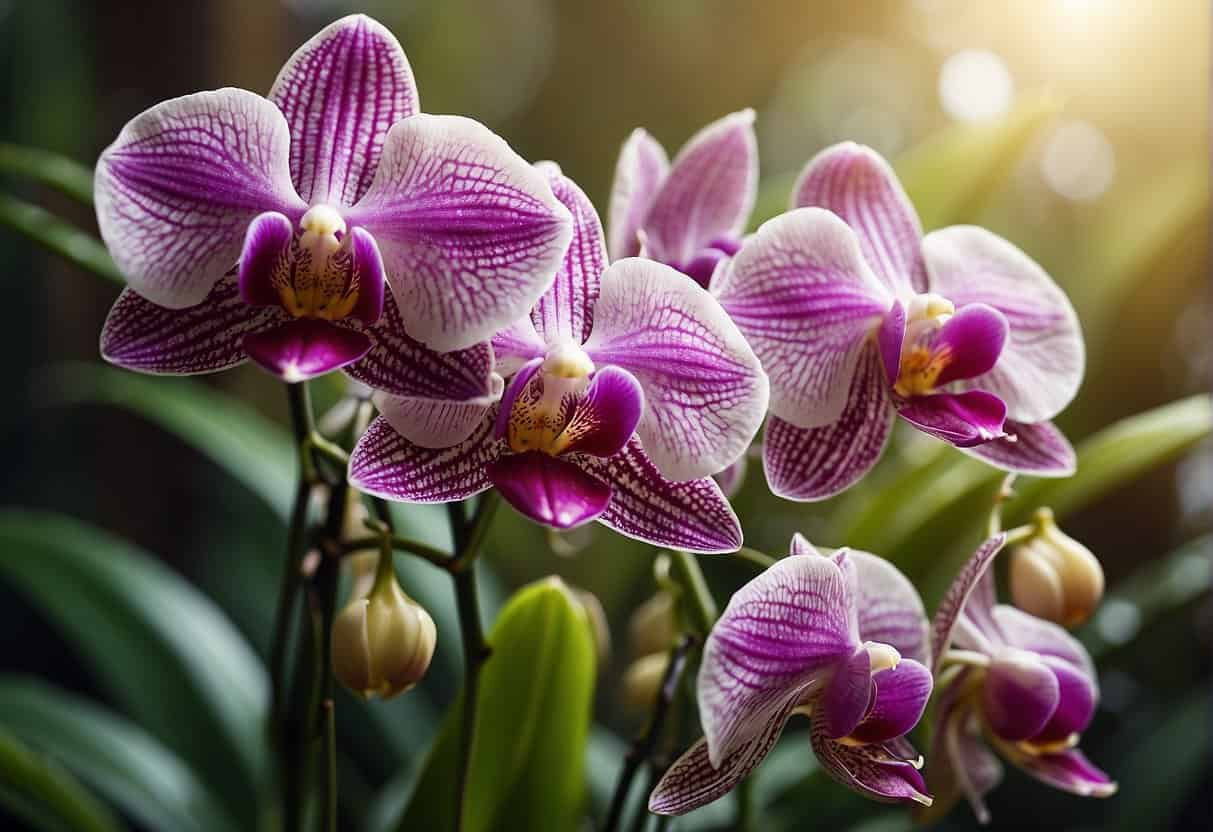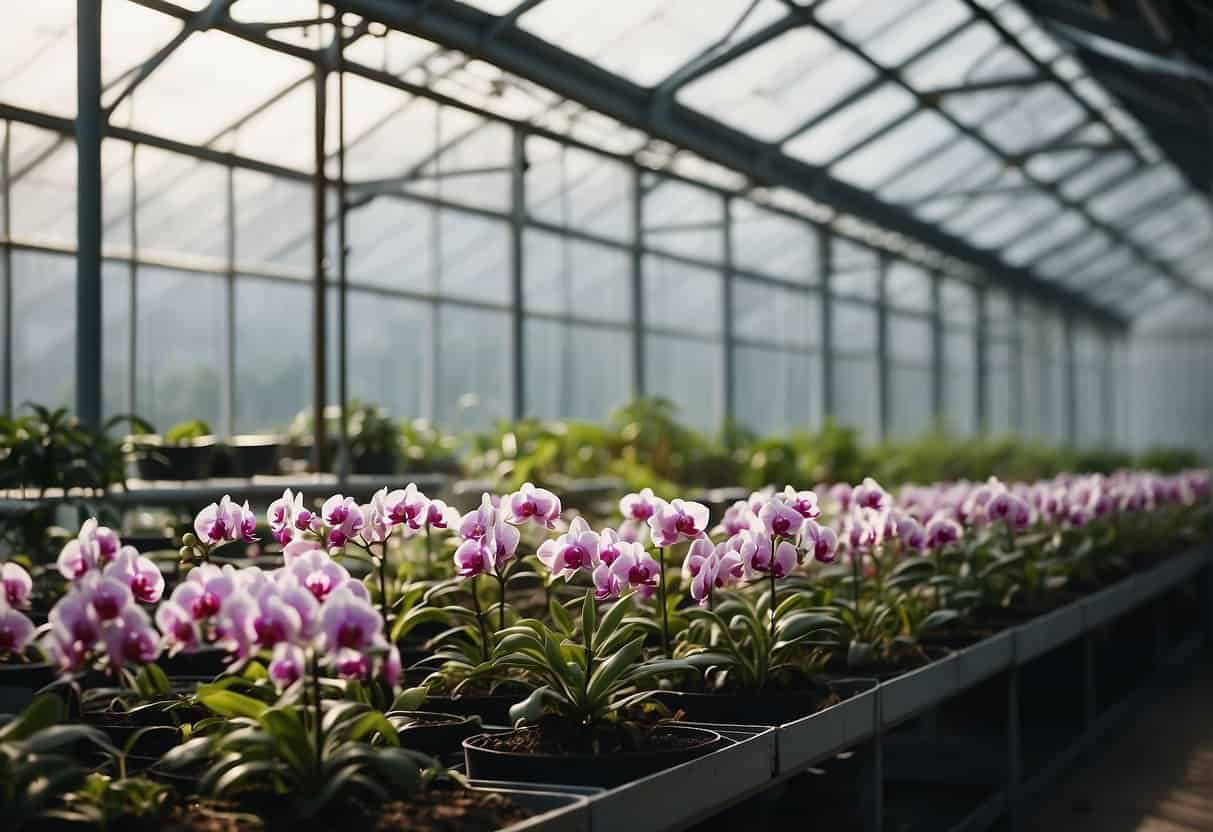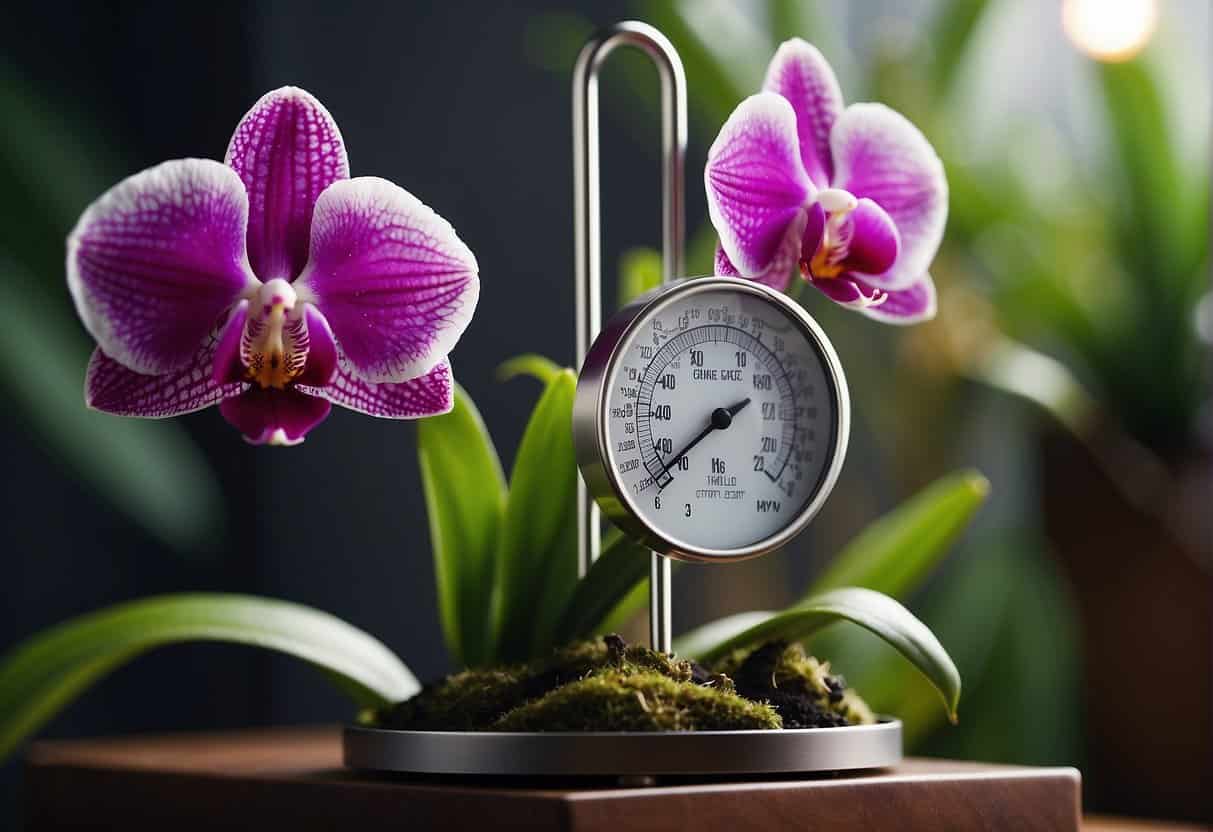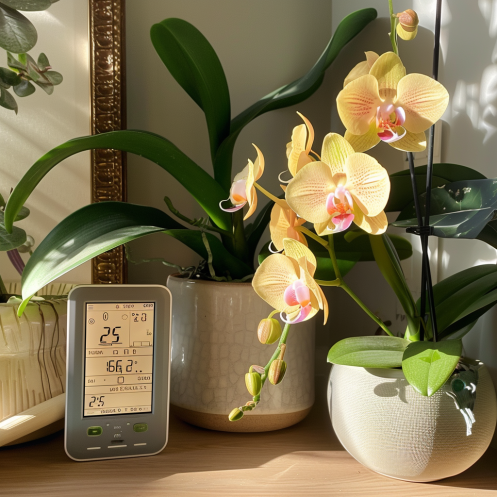Orchid enthusiasts understand that temperature plays a pivotal role in the health and bloom cycles of their cherished plants.
Orchids, with their diverse species, exhibit a range of temperature preferences that are essential to mimic for successful growth.
Orchid temperature requirements vary widely; some species flourish in the warmth, while others demand cooler conditions.
A primary consideration for orchid care is providing the right temperature range to ensure not only survival but also to stimulate the flowering process, which for many growers is the ultimate reward of their efforts.

Properly managing the temperature for orchids involves more than just setting a thermostat. It requires an awareness of daily and seasonal fluctuations that occur in an orchid’s natural habitat.
Warm-growing orchids typically enjoy daytime temperatures between 80-90°F and nighttime temperatures of 65-70°F, but this varies among species.
In contrast, cool-growing varieties prefer 60-70°F days and cooler nights down to 50-55°F.
This distinction is particularly important during the winter months, which can be a critical period for orchid care.
The key to thriving orchids lies in the balance between day and night temperatures, as well as the gradual transitions between seasons.
A drop in temperature at night, generally around 10-15°F, is crucial for many orchid species to initiate blooming.
Caretakers must strive to recreate these conditions as closely as possible.
With careful monitoring and control of environmental factors, orchid growers can create the ideal climate for their plants to prosper and exhibit their stunning blossoms.
Understanding Orchid Temperature Preferences
To cultivate orchids successfully, one must provide conditions that closely mimic each species’ native environment, particularly concerning temperature.
Temperature significantly influences the orchids’ growth patterns and metabolic processes.
Temperature Ranges for Different Orchid Species
Orchids exhibit diverse temperature preferences based on their species.
For instance, Phalaenopsis orchids, often referred to as moth orchids, thrive in temperatures typically between 65 and 85 degrees Fahrenheit, with nighttime temperatures 10 degrees cooler to promote blooming.
Cattleyas favor similar daytime temperatures but can withstand a drop to 60 degrees at night.
On the other hand, Cymbidiums are quite adaptable to cooler climates, with ideal temperatures ranging from 50 to 70 degrees.
Dendrobium orchids also exhibit a broad range, accommodating environments from intermediate to warmer climates.
Higher temperatures may be preferred by Vanda orchids, which flourish in conditions similar to their tropical origins.
Adapting to the Orchid’s Native Habitat
Each orchid species has evolved to flourish in specific conditions related to the climate of its native habitat.
For example, Dendrobium species originating from warm, moist lowlands will have different temperature needs compared to those that have adapted to the cooler, higher elevations.
Orchids like Cattleya and Paphiopedilum originate from varied elevations in tropical regions, which influence their ideal temperature ranges, necessitating warmer days with a moderate drop at night.
Effects of Temperature on Orchid Growth and Metabolism
Temperature directly impacts an orchid’s growth and metabolism.
Photosynthesis and respiration are temperature-dependent processes that affect the orchid’s ability to thrive.
During their actively growing phase, orchids demand stable temperatures within their species-specific range to optimize their health and flowering potential.
For example, too-high temperatures can accelerate respiration over photosynthesis, leading to energy deficits, while too-low temperatures may slow down growth and inhibit flowering.
Creating the Ideal Growth Environment
To cultivate orchids successfully, growers must create an environment that closely mimics the natural conditions these plants thrive in.
This requires precise control of temperature, humidity, air movement, and light.
Controlling Temperature in the Growing Area
Different orchids have varied temperature preferences, broadly classified into cool, intermediate, and warm growers.
For cool-growing orchids, daytime temperatures should be between 60-70°F, with nighttime lows of 50-55°F.
Intermediate orchids flourish at daytime temperatures of 70-80°F and night temperatures of 55-65°F.
Warm-growing orchids prefer daytime highs of 80-90°F and nighttime temperatures between 65-70°F.
Utilizing a thermometer to monitor these temperatures is crucial for maintaining the optimal range.
In a greenhouse setting, growers can use heating and cooling systems to manage the heat, ensuring stable growing conditions.
- Cool-Growing: Day: 60-70°F, Night: 50-55°F
- Intermediate: Day: 70-80°F, Night: 55-65°F
- Warm-Growing: Day: 80-90°F, Night: 65-70°F
Managing Humidity and Air Movement
Orchids require a humidity level between 40% and 70% to thrive.
Devices such as humidifiers can help maintain these levels in an indoor environment.
However, adequate air movement is equally important to prevent diseases and ensure that the stomata on orchid leaves can function properly.
Using fans to promote air circulation is recommended.
A balance of humidity and airflow mimics the natural breezes of orchids’ native habitats and supports healthy growth.
- Humidity: 40%-70%
- Use fans for air circulation
Providing Adequate Light Without Overheating
Orchids need bright light but not direct sun, which can cause overheating and damage.
In a greenhouse or indoor setting, shade cloth can diffuse intense sunlight, preventing sun exposure from becoming detrimental.
Orienting the orchids to receive adequate morning light with protection during the hottest part of the day helps in striking the right balance.
The goal is to mimic dappled light conditions, under which many orchids naturally grow.
Seasonal Temperature Considerations
Seasonal changes significantly affect orchid care, particularly in maintaining appropriate temperature ranges that encourage blooming and prevent stress.
Protecting Orchids During the Winter Months
During the colder months, it is critical to protect orchids from frost and ensure they’re not exposed to temperatures that could cause the flower spike to wither.
Orchids need temperatures between 50° F and 80° F (10° C to 27° C), with some variance depending on specific species.
To mitigate the risk of heat loss and potential frost damage, one may increase room insulation or use heat mats strategically.
Adjusting Care in High Heat and Direct Sunlight
Orchids are susceptible to heat stress and sunburn during the summer months.
Maintain a stable environment where temperatures do not exceed 80°F (27°C) during the day.
Providing shade and increasing air circulation can help safeguard orchids from harsh sunlight.
Regular misting helps keep them hydrated, but caution is required to avoid excessive humidity that can lead to fungal issues.
Transition Periods Between Seasons
Orchids respond to temperature fluctuations between seasons, particularly the changes between day and night temperatures, which can trigger blooming.
As a season transitions into another, gradually adjusting your orchid’s environment is key.
This includes potentially relocating the plant within the home to suit varying temperature ranges and careful monitoring to adapt care routines such as watering and feeding to the orchid’s changing needs.
Orchid Care Through Temperature Fluctuations

Orchids require specific temperature conditions to thrive and bloom. Understanding the diverse needs of cool-growing, warm-growing, and intermediate orchids, especially the critical role of nighttime temperature fluctuations, is essential for the cultivation and health of these plants.
Ensuring Thriving Conditions for Cool-Growing Orchids
Cool-growing orchids, such as Masdevallias, flourish in environments where the daytime temperature range is typically between 60-70°F (15-21°C) and nighttime temperatures fall to about 50-55°F (10-13°C).
To ensure the health of these orchids and the potential for flower spikes to develop, maintaining this cooler temperature bracket is paramount.
During the colder months, growers must be vigilant to prevent temperatures from dropping too low, which may hinder the orchid’s growth or cause green leaves to blacken due to chill damage.
Caring for Warm-Growing and Intermediate Orchids
Warm-growing orchids prefer temperature ranges of 80-90°F (27-32°C) during the day and 65-70°F (18-21°C) at night.
Meanwhile, intermediate orchids thrive when temperatures are 70-80°F (21-27°C) during the day and 55-65°F (13-18°C) at night.
Both warm-growing and intermediate orchids require less dramatic temperature drops at night compared to cool-growing species, but consistency within their respective temperature bands is crucial for their overall health and to trigger flowering.
The Role of Nighttime Temperatures in Orchid Health
Nighttime temperatures serve a critical role in the cultivation of all orchids.
A drop of about 10-15°F (5-8°C) from daytime highs is necessary to initiate the flowering process in many species by encouraging the formation of flower spikes.
Orchids rely on these cooler night temperatures to effectively carry out gas exchanges, which is vital for maintaining the health of these exquisite plants.
Their unique respiratory patterns make the colder nighttime environment essential for regenerating and processing energy to sustain vibrant growth and flowering.
Maintaining Healthy Orchids: Beyond Temperature

To ensure the vibrance and longevity of your orchids, one must look beyond mere temperature management. An orchid’s overall health is interconnected with precise watering, fertilization, protection from harm, and proper handling during pivotal growth phases.
Optimizing Water and Fertilizer Routines
Watering should be conducted with care; orchids prefer their potting medium to remain moist but not waterlogged.
Moth orchids and other members of the Orchidaceae family may require watering every 5 to 7 days, depending on humidity levels.
For fertilizing, use a balanced 20-20-20 fertilizer at half strength to avoid toxicity, typically once a month during the growing season to promote robust growth and blooms.
Preventing and Treating Diseases and Pests
Orchids can fall victim to diseases and pests, with black rot being among the most damaging.
To protect these delicate plants, one should regularly inspect for signs of distress, such as discoloration or wilting.
If pests like aphids or spider mites are identified, they can be managed with insecticidal soap or neem oil. Apply the soap or oil with precision to minimize damage.
Repotting and Caring for New Seedlings and Blooms
Repotting is crucial for maintaining orchid health. It should be done every few years or when the potting medium begins to break down.
Use a lightweight potting mix designed for orchids for best results.
For new seedlings, maintain stable moisture levels and avoid over-fertilizing.
When blooms fade, cut the flower spike an inch from the base to encourage rebloom. Handle mature plants with care to protect their delicate structures.
Advanced Techniques for Orchid Temperature Control

Effective temperature control is essential in orchid cultivation to emulate natural conditions that encourage growth and blooming.
Advanced techniques involving technology and precise adjustments can greatly enhance climate management within orchids’ environments. These techniques are applicable to home, greenhouse, or indoor settings.
Utilizing Evaporative Cooling Systems
Evaporative cooling systems are a sophisticated method used to regulate temperatures in environments where orchids are grown.
These systems work on the principle of evaporative cooling, where water is evaporated to absorb heat, thereby cooling the surroundings.
In a greenhouse, setup can include strategically placed pads soaked with water and a fan system that pulls air through the pads.
This method can efficiently reduce temperatures, keeping them within the 60-80°F (15-27°C) range, which is ideal for many orchid species.
Innovations in Orchid Cultivation and Climate Management
Orchid cultivation benefits from innovations like automated climate control systems that can monitor and adjust parameters such as temperature, humidity, and pH levels.
These systems can provide real-time data and environmental adjustments based on the specific requirements of the orchids, ensuring conditions are always optimal.
- Climate Controllers: Devices that constantly assess temperature and make necessary adjustments.
- Smart Greenhouses: Structures that integrate sensors and IoT technology for dynamic climate management.
By incorporating these technologies, growers can maintain precise control over the climate, creating ideal micro-environments for orchids to thrive.
Monitoring and Adjusting Micro-Environments
Monitoring micro-environments involves observing the small-scale climate conditions around each orchid or group of orchids. This is key in indoor and greenhouse settings where individual orchids may have varying needs.
Tools like digital thermometers and hygrometers can provide accurate readings of the temperature and humidity.
After getting the readings, adjust the local environment using:
- Localized Shade Cloths: To control light intensity and temperature.
- Misting Systems: To increase humidity and ambient temperature through direct application of moisture.
Through vigilant monitoring and tailored environmental tweaking, gardeners can establish the proper conditions for each orchid’s unique requirements, which is critical for their successful growth and flowering.
Frequently Asked Questions

Orchid enthusiasts often inquire about the specific temperature requirements for different orchid types. Understanding these requirements is crucial for the health and blooming success of the plants.
What is the ideal temperature range for Phalaenopsis orchids?
Phalaenopsis orchids, also known as “moth orchids,” prefer a warm climate with daytime temperatures around 75 to 85°F and nighttime temperatures not falling below 65°F.
How can I protect my orchids from temperatures that are too high?
To safeguard orchids from excessive heat, provide shade, ensure adequate airflow, and maintain high humidity. These measures help prevent tissue damage and stress on the plants.
What temperature conditions are best for growing Dendrobium orchids?
Dendrobium orchids flourish in moderate climates. Aim for daytime temperatures between 65 to 75°F and slightly cooler nighttime temperatures, though they can tolerate a wider range.
At what temperature range do Vanda orchids thrive?
Vanda orchids are accustomed to warm environments and prosper when daytime temperatures are between 80 to 95°F and nighttime temperatures stay above 65°F.
How do different temperature ranges affect Cattleya orchid growth?
Cattleya orchids are versatile, but they grow best when daytime temperatures range from 70 to 85°F, and nighttime temperatures are kept between 58 to 65°F.
Can warm-growing orchids tolerate temperatures around 90 degrees Fahrenheit?
Most warm-growing orchids can tolerate temperatures around 90°F. They especially thrive if the warmth is coupled with high humidity and strong airflow. However, they require cooler night temperatures to mimic their natural tropical environment.


